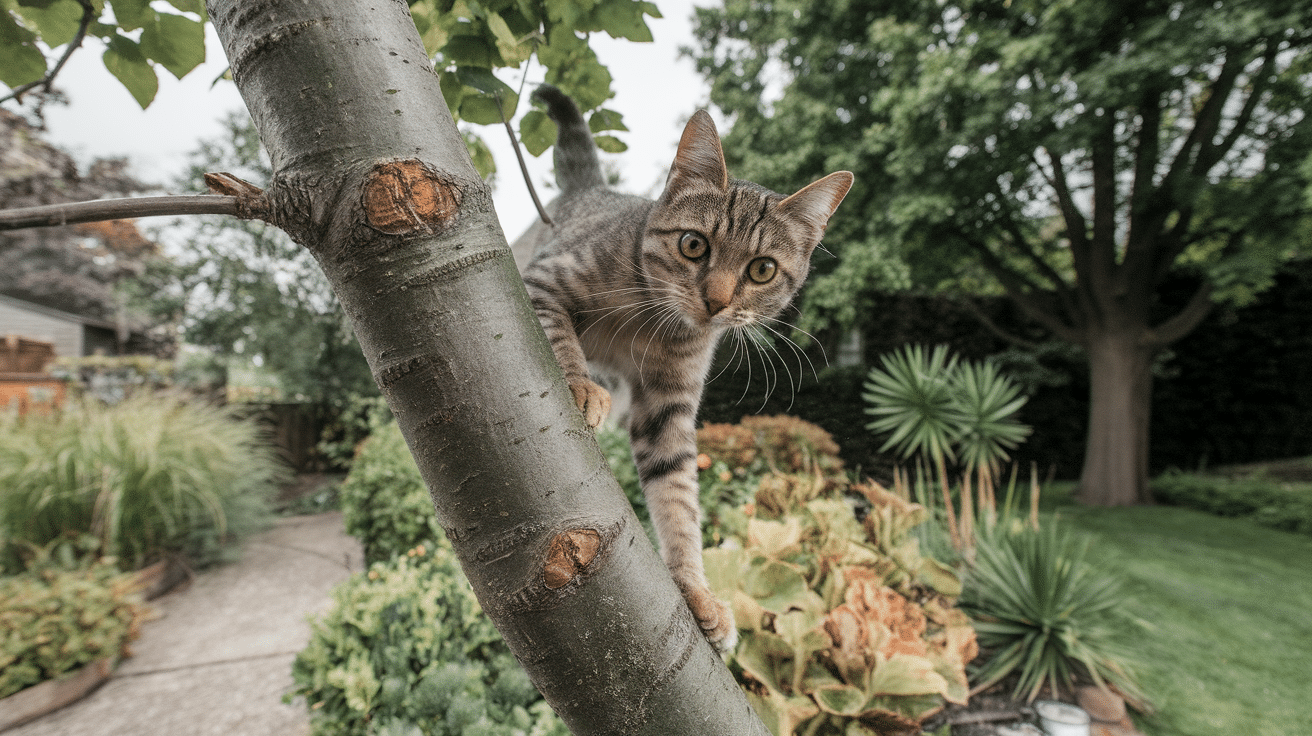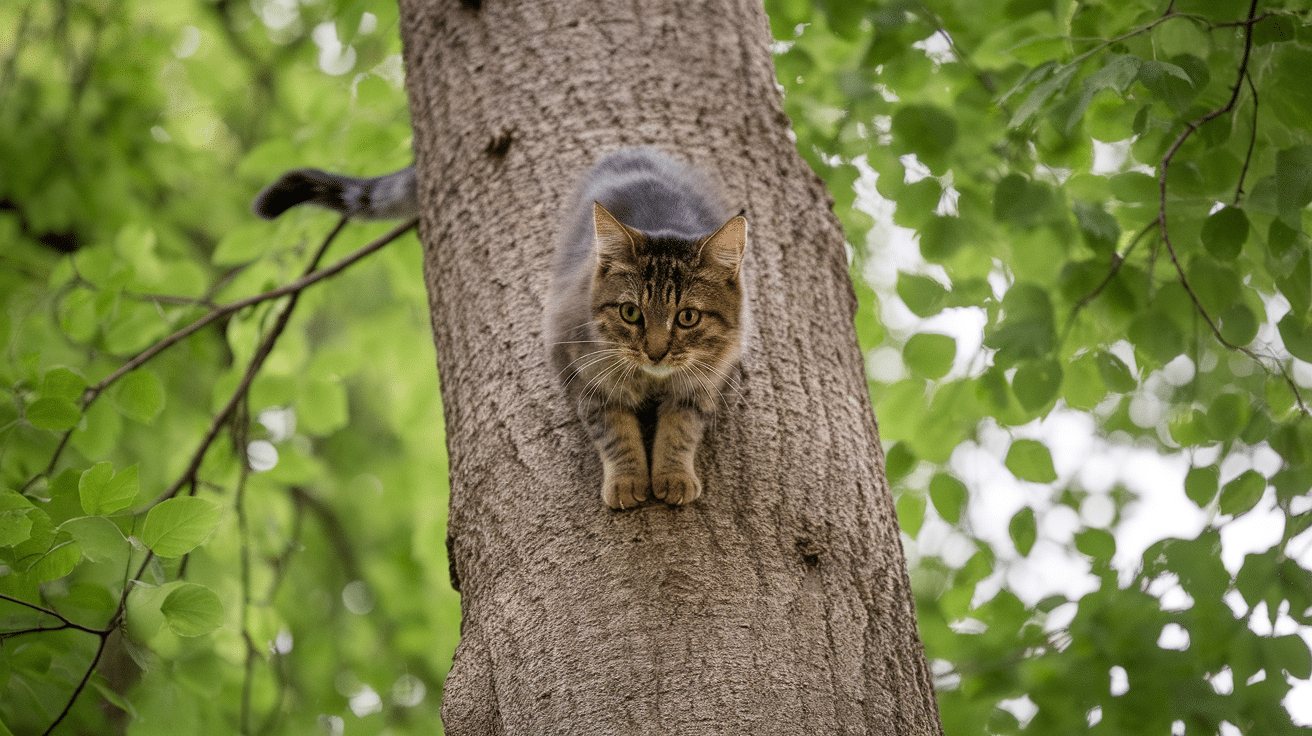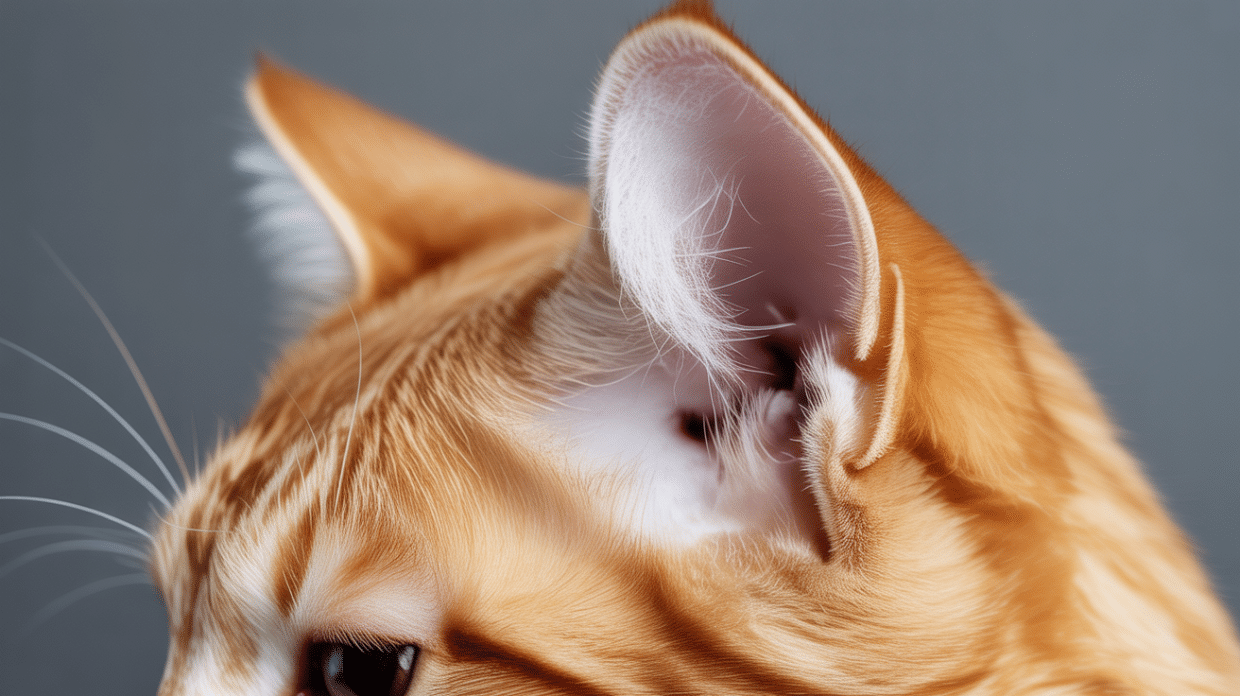We’ve all heard the classic scenario: A cat is stuck in a tree, and someone needs to rescue it.
But why does this happen so often?
Cats are excellent climbers, and their sharp claws are perfect for scaling trees. However, these same claws create a unique problem.
Their curved design works wonderfully for climbing up but makes coming down much more challenging.
Adding to the problem, fear often takes over once cats reach certain heights.
Their depth perception can mislead them about how high they are, making them too scared to attempt the jump down.
This blog covers all that you need to know about cats getting stuck in trees. Keep reading!
The Mechanics of Cat Climbing

Cats and trees – a classic mix that often leads to problems. While these quick animals can easily climb up the tallest trunks, getting back down is another matter.
1. Why Cats Climb Trees
Cats climb trees due to their instincts and to escape danger.
They evolved as skilled upward climbers, but nature didn’t equip them equally well for the journey down.
2. The Role of their Claws
When climbing, a cat’s curved claws work like hooks, gripping tree bark perfectly.
This same design fails them when descending head first.
To use their claws effectively coming down, cats need to back down—a movement they find difficult and unnatural.
3. Lack of Foot Rotation
Unlike squirrels, cats cannot rotate their hind feet. Their ankle joints don’t allow the rotation to grip a tree trunk when descending head first.
Without this ability, cats must either awkwardly back down or risk jumping from a height, often becoming stuck.
Why Cats Get Stuck
When cats find themselves high in a tree, several psychological factors prevent them from returning to solid ground.
Fear Factor
Once a cat climbs high in a tree, fear takes over. What seemed like a good idea going up becomes frightening when looking down.
This fear can completely stop a cat from attempting to descend, even if they can physically jump safely.
Many cats freeze in place, meow for help, or cling tightly to branches.
As time passes, hunger, thirst, and fatigue increase stress, making them even less likely to try coming down.
Poor Depth Perception
Cats have trouble judging distances accurately when looking downward.
While climbing up, they don’t fully realize how high they’re going. They become aware of the true height when they need to descend.
This misjudgment makes cats hesitant to jump, as safe distances become unclear.
Their natural caution, combined with this visual limitation, keeps many cats firmly stuck in their treetop predicaments.
Can Cats Climb Down Trees?

Cats do have the physical ability to descend trees, though not all know how to use this skill effectively.
Some cats can climb down trees by backing down tail-first, which allows their claws to grip properly.
This backward climbing motion requires coordination that many cats develop through regular outdoor experience.
However, many cats get stuck despite having this capability.
Inexperienced climbers may not know the proper technique, while even experienced ones might become stuck when climbing unusually high trees.
Weather factors like rain or wind can make branches slippery, making a normal descent risky.
Cats often stay put rather than attempt a dangerous climb down in these situations.
The combination of inexperience, unusual height, and environmental conditions explains why even naturally skilled climbers sometimes need help getting back to the ground.
What to do When Your Cat Gets Stuck
Finding your cat stuck in a tree can be stressful, but taking the right steps can help resolve the situation quickly and safely.
Immediate Actions
Stay calm – your anxiety can make your cat more nervous.
Give your cat some time, as many will come alone within 24 hours.
Place your favorite food at the tree’s base and call them with a calm, familiar voice.
Avoid loud noises or sudden movements that might frighten them further.
When to Call for Professional Help
If your cat remains stuck for more than 24 hours or seems distressed, seek professional assistance.
While many people think of the fire department, their availability for cat rescues varies by location.
Consider contacting:
- Professional tree services with cat rescue experience
- Dedicated cat rescue specialists
- Animal control or local animal welfare organizations
These professionals have the proper equipment and know-how to safely retrieve your cat without causing additional stress.
Avoid attempting dangerous climbs yourself, which could injure or frighten your cat.
Preventing Cats from Getting Stuck in Trees
While you can’t entirely stop cats from following their climbing instincts, you can take steps to prevent tree troubles before they happen.
Preventive Tips:
- Supervise outdoor time for cats that aren’t experienced climbers.
- Keep sessions short and stay nearby to intervene if your cat starts climbing too high.
- Create alternative climbing spaces by installing cat trees or shelves in your home.
- These give cats safe places to satisfy their climbing urges without the risks of actual trees.
- Consider using deterrents around tree trunks in your yard
- Trim lower branches to make it harder for cats to start their climb.
- Provide plenty of vertical space and climbing opportunities inside for indoor cats, making them less likely to dash for trees during escapes.
- Regular play sessions also help burn energy that might otherwise be spent on risky climbing adventures.
Conclusion
While cats are skilled climbers with instincts that drive them up trees, their physical limitations often prevent them from returning safely.
Once they reach the treetops, their curved claws, inability to rotate their feet, and fear of heights work against them.
If your cat becomes stuck, remember that patience is key.
Give them time to come down independently before trying food and gentle coaxing.
When these methods don’t work, don’t hesitate to call professionals who can safely retrieve your feline friend.
Understanding why cats get stuck in trees helps us respond better when it happens, ensuring these curious climbers return safely to solid ground.






